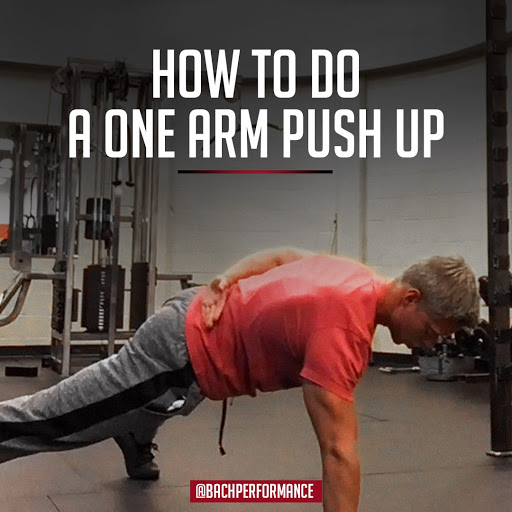How To Do A One Arm Push Up
March 26, 2020
One arm push ups are more than a party trick. They’re an incredible feat of total body strength and underrated muscle builder.
I’ll break down the benefits in a moment. But first, a question:
Have you ever noticed the amazing physiques of elite-level gymnasts despite the fact that they train only with bodyweight?

The vast majority of gymnasts could step on stage at a bodybuilding show and hold their own.
This underscores the missing muscle-building component the majority of lifters don’t understand: Tension.
Do One Arm Push Ups Build Muscle
In short, yes. One Arm Push ups trigger three key drivers for muscle growth in training.
1. Metabolic Stress. The pump comes from keeping muscles under constant tension with incomplete rest. When you create metabolic stress, there’s a build up of lactate, hydrogen ions, creatinine, and other metabolites. This occurs because the constant muscular contractions prevent blood from escaping. It creates a pooling effect of these byproducts which stimulates the signals for muscle growth.
2. Muscular Damage. Soreness shouldn’t be a primary goal, but a secondary response of challenging your body just past its point of recovery. Slight amounts of soreness create a temporary inflammatory response and release anabolic signals for muscle growth. I urge you to proceed with caution here. Muscular damage should be a byproduct of a strategic training program, not the primary goal. If you’re crippled with soreness and it impairs workout frequency for performance, you’re doing more harm than good.
3. Mechanical Tension: The big daddy of them all, mechanical tension is achieved by creating lots of, you guessed, tension in your muscles. Lifting progressively heavier weights and doing so in a controlled manner adds the element of time under tension. This is the obvious option for building muscle. But hiding in plain sight is your ability to maximize intramuscular tension through manipulating leverage while using more advanced bodyweight exercises.
All of which brings us right back to one-arm push ups. 
- A typical push up from the knees forces you to lift about 49% of your body weight.
- Regular push-up forces you to lift about 64%.
- Elevating your feet on a 24cm step, and we’re looking closer to 75%.
Source: The Cooper Institute
So, how about a one-arm push-up? Frankly, I haven’t been able to drum up the exact percentage of body weight you’d lift.
But let’s use some logic here. You’re lifting close to that same amount (75% of your body weight) per-rm, creating a substantially higher training stimulus with a one arm push-up than you could with a regular push-up.
There is definitely a level of skill involved that may prevent many lifters from being able to maximally fatigue all muscles involved in the one arm push up. But it’s fairly straightforward to understand you’re creating TONS of tension on your chest, deltoids, and triceps when performing a one-arm push up.
What does the one arm push train, anyway?
The one arm push-up is a unilateral, compound movement training a plethora of muscles throughout your body.
One Arm Push Ups Build Your Chest, Triceps, and Shoulders
Think of push-ups like a moving plank (anti-extension) that also trains your chest, deltoids, triceps, lats, traps (shoulder stabilization) serratus anterior (shoulder stabilization).
As mentioned above, single-arm push-ups place a TON of load directly on your chest, deltoids, and triceps. That’s -plenty to build muscle if they’re programmed correctly. You’ll also notice a deep soreness in your lats as the stability requirements of a one-arm push-up may shock your system.
One Arm Push Ups Smash Your Core
A push-up is actually a moving plank. Each rep forces you to prevent extension or arching of your lower back. When done correctly, push-ups train your anterior core (rectus abdominis).
By removing a limb from the ground, you’re adding an element of anti-rotation.
Superficially, this trains your obliques, which live underneath your love handles. More importantly, you’ll be training deep core stabilizers like your quadratus lumborum to work double-time to prevent unwanted movement through your hips and spine. Developing the ability to resist unwanted rotation can make you stronger in big, compound exercises like squats but also prevent rotation-based injuries from a rickety golf swing to shoveling snow.
Your hips will be working double-time to aid in stabilizing your pelvis as well.
A Step By Step Progression To Learning The One Arm Push Up
Few exercises can match the tension created in the one arm push up. Below is a step-by-step progression to work your way up to a one arm push up. For some, this will take a matter of weeks. For others, it may be months.
Master each exercise and be able to perform 10 perfect reps before moving to the next.
1. Hands elevated push up.
2. Dead stop push up: Complete stop with your chest on the ground between reps. Don’t allow your hips to sag. Keep your core engaged at all times.
3. Feet elevated push up.
4. One arm hands elevated Isometric Push Up (lower chest to the bench, pause and hold for 5 seconds. Reset, repeat).
5. One arm hands elevated push up.
6. One Arm isometric push up (lower chest to bench, pause and hold for 5 seconds. Reset, repeat).
7. One Arm Push up.
8. One Arm feet elevated push up.
As you can see, this is a straightforward, logical progression.
You can begin the progression with the most advanced pushup variation you can currently do.
You advance from one push-up variation to the next by adjusting the leverage of the push-up first, then removing a limb. This allows you to progressively build strength and stability.
How To Program The One Arm Push Up
Relative Strength. Because you’re moving your body weight through space, the key here is high levels of relative strength, or being strong for your size. The leaner (and/or smaller) you are, the easier this progression will be.
Dropping unwanted body fat while maintaining strength will lead to a dramatic increase in strength when it comes to bodyweight exercises.
High Training Frequency. Strength is movement-specific. The more frequently you perform a movement correctly, the faster you’ll rewire your nervous system for optimal performance. I recommend training the most advanced variation you can at the beginning of your workouts OR 3-4 hours apart from your main training for optimal results.
Avoid Excess Fatigue (in the beginning): To train a movement or muscle frequently, avoid going to failure. Training too hard too often will overload your recovery capabilities and prevent you from optimally recovering.
Worse still, training an unfamiliar movement pattern to failure will result in technical flaws, teach bad technique and increase your injury risk.
 You don’t build strength by TESTING it, you build strength by TRAINING it.
You don’t build strength by TESTING it, you build strength by TRAINING it.
Leave a few reps in the tank, fully recover, and train the movement often. Once you’ve built up the strength skill, you can pile on the volume needed to grow.
Slow Down. Create Tension
Mindlessly repping out push-ups might “feel” cool, but the key to making any exercise more effective for building muscle is to maximize tension within the muscle.
This protects your joints as well. Take 3-4 seconds down, grip the floor with your hand, squeeze your glutes and your quads to create as much tension as you can.
The Takeaway
Whether you’re strapped for equipment or not, bodyweight training is an incredibly powerful tool.
Instead of using it only for high volume work, pivot your approach and focus on maximizing tension, working up to the most advanced versions you can. Not only will you enjoy the process and results, but you’ll also leave equipped with the skills to get a great workout anytime, anywhere.
Are you looking for more simple-to-follow MINIMALIST Workouts?
Grab your FREE copy of the Chiseled Muscle Cheatsheet








